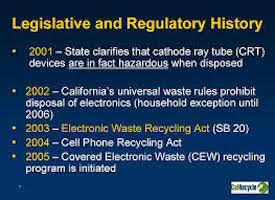
In 2003, California passed legislation considered landmark in the United States: the Electronic Waste Recycling Act. It made major changes to how certain electronic devices can be manufactured and sold in the state. Implemented in 2007 and subject to updates, both producers and consumers have felt the impact of this act.
What Is the Electronic Waste Act?
While considered a bold move in the U.S., the Electronics Waste Recycling Act is actually deeply tied to legislation already enacted by the European Union. In the EU, member countries must adhere to the Restriction of the use of Certain Hazardous Substances. This sites a list of specific substances known to be harmful to humans or the environment, and limits their use in the manufacture of electronics.
What Does the SB 20 Act Cover?
Although tied to the EU’s RoHS, the California act is more limited in scope. It only applies to devices that possess a video display screen equal to or larger than four inches, and restricts use of the following substances:
- Hexavalent chromium
- Mercury
- Lead
- Cadmium
There are some device exemptions listed in RoHS and the EWRA has verbiage allowing for similar exemptions to be made.
The EWRA also created an Electronic Waste Fee, paid by consumers on particular electronic devices. This fee funds recycling programs for the items in question. These recycling programs are available to consumers at no-cost and are intended to decrease the amount of electronic waste that ends up in landfills. In addition to providing public and environmental health benefits, the recycling programs save useful elements that can then be reused in future manufacturing.
Why Was It Implemented?
The California legislature formulated the EWRA in response to a dire environmental and health concerns. When the above-mentioned substances aren’t properly disposed of, they can end up in the environment. This affects wildlife, plant life and people.
While proper disposal and recycling are certainly effective strategies to decreasing the amount of toxic substances in the local air, soil and water, preventative measures that limit their initial presence can be even more so. With the introduction of RoHS in the EU, California had a successful template it could use to tackle these problems.
What Does It Mean for Your Business?
Most businesses outside of electronics manufacturing don’t experience much of a difference as a result of the EWRA, although your company may have to pay the Electronic Waste Fee when purchasing applicable electronic devices. Electronic manufacturers must comply with the concentration limitations and prove they are doing so by submitting annual reports to the Department of Toxic Substances Control. The intent of the Act is to provide cost-free recycling opportunities for consumers and mechanisms for companies, to reduce/prevent illegal dumping of electronic waste, and to decrease the hazardous materials entering the municipal solid waste stream. To this extent, the SB 20 helps provide guidelines of best practices for institutions in the disposal of electronic items.
TechWaste Recycling directly services all of Southern California and provides pickup services to its facilities from nationwide locations. Visit TechWaste Recycling’s website at www.techwasterecycling.com to schedule a pickup that works for your convenience and schedule.
Learn more about TechWaste’s electronic recycling process and certifications here: Certified Electronic Recycling
Contact Info:
Richard Steffens
1940 E. Occidental street
Santa Ana, CA 92705
Phone: 866-637-8469

































